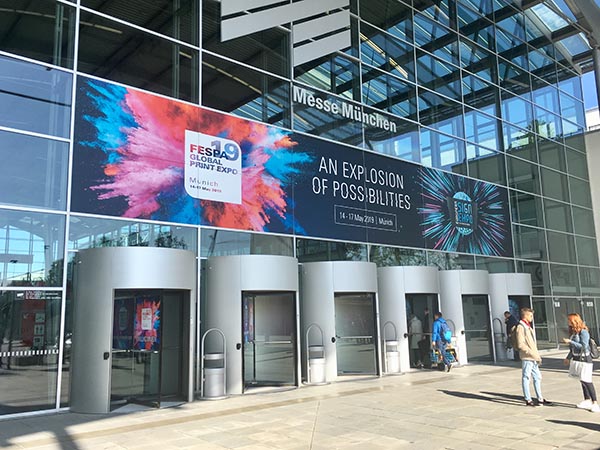- Based on the responses from the FESPA Census, the 2019 show included an expanded Print Make Wear zone dedicated to fast fashion as well as a “Printeriors” exhibit area highlighting interior décor applications and for the first time, exterior applications.
- Based on the Trend Theatre sessions and the chatter on the show floor, automation and efficiency are at the forefront for today’s wide format producers.
- In relation to years past, FESPA attendees are becoming more interested in how to implement automation to improve their operations and increase overall efficiency.
By Ryan McAbee

Introduction
The FESPA 2019 tradeshow kicked off this week in Munich, Germany—the land of beer and brats. This year’s event drew attendees on a global scale under the theme of an “Explosion of Possibilities.” The organizers of the event expanded key features based on feedback from the 2018 Print Census research, which was executed last year via a partnership with Keypoint Intelligence – InfoTrends. Based on the responses from the FESPA Census, the 2019 show included an expanded Print Make Wear zone dedicated to fast fashion as well as a “Printeriors” exhibit area highlighting interior décor applications and for the first time, exterior applications. Show organizers also launched the Colour L*A*B* to educate wide format printers on how to control and optimize color quality. Lastly, the Trend Theatre offered 38 learning opportunities with several featuring InfoTrends’ analysts.
Software Solution Highlights
While there are many advancements in ink, materials, and printing equipment being announced at the show, my focus turned to software solutions that were designed to improve the supply chain, shop management, production workflow, and fulfillment. Based on the Trend Theatre sessions and the chatter on the show floor, automation and efficiency are at the forefront for today’s wide-format producers. At the same time, however, reaching the heights of shop automation to reap these operational rewards will require a shift in strategy—software spend averages below €15,000 for most businesses.
The good news is that there are a growing number of solutions designed to save time, materials, and cost, while also providing key information so owners, managers, and staff members can monitor and continually improve their operations. In relation to years past, FESPA attendees are becoming more interested in how to implement automation to improve their operations and increase overall efficiency. The following is a sampling of software activity on the show floor from day 1:
- Adobe promoted its Adobe Textile Designer toolset (also known as Project Paras) for Photoshop that enables designers to visualize design elements in relation to the pattern repeat as well as managing colorways for conventional and digital printing.
- In recent years, Durst has focused on eliminating production bottlenecks ahead of the printing process by building up three core workflow tools: Durst Shop, Workflow, and Analytics. Durst Shop is web-to-print software that has all the modern features one would expect, including 3D and contextual product visualization (simulated views of how it looks installed). Shop works in tandem with Durst Workflow to then handle common file preparation tasks including nesting of work to save material and printing time. Finally, customers can view key equipment performance data, to monitor uptime performance, via the customizable Durst Analytics dashboard. The data is accessible to other software applications (e.g., Print MIS or ERP solutions) via an API set.
- EFI announced updates to its Fiery proServer that doubled the product’s processing power. Fiery Intensify, a new Fiery feature that modifies the color gamut of the image to make the color appear more saturated and visually intense without using more ink, was also launched. Other parts of the mid-market suite (e.g., Digital Storefront, Pace, and MarketDirect) were also demonstrated at the show.
- ONYX announced that it will be releasing version 18.5 of its popular software offering, which includes updates to the Adobe PDF Print Engine (APPE 5.1), support for PDF 2.0 format, and new tools for color and file enhancements.
- SAi demonstrated its newly released SaaS-based Flexi software, which is used for print-and-cut applications produced by sign shops.
The Bottom Line
FESPA 2018, held in Berlin, Germany, attracted a total of 20,442 visitors. By all indications, this year’s show is expected to top that total. FESPA 2019 highlighted the many opportunities and applications that are possible with wide format printing in the sign & display, apparel, décor, and packaging segments. Print service providers that are already entrenched in these segments are now seeking better ways to optimize their operations, introduce new applications, and provide integrated solutions to thrill their customers.
Prost from Germany!














